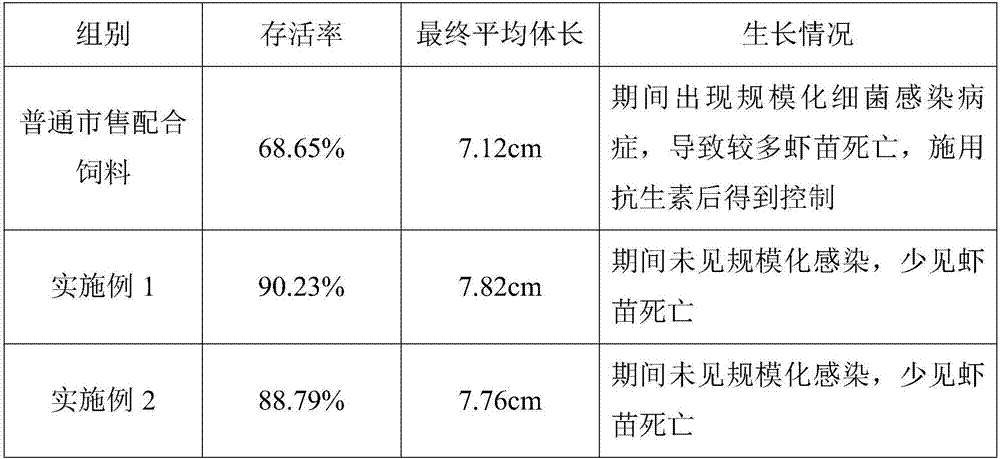Whiteleg shrimp fodder
A technology for white shrimp and feed, which is applied in animal feed, animal feed, climate change adaptation and other directions, can solve the problems of increasing the difficulty of shrimp digestion, absorption and utilization, and complex nutrients, so as to enhance animal immunity, disease resistance and food intake. Fast and digestible
- Summary
- Abstract
- Description
- Claims
- Application Information
AI Technical Summary
Problems solved by technology
Method used
Image
Examples
Embodiment 1
[0018] A feed for Penaeus vannamei, calculated in parts by weight, comprising the following raw materials: 24 parts of fermented soybean meal, 6 parts of hemoglobin powder, 6 parts of broken yeast, 8 parts of steamed fish meal, 4 parts of shrimp shell powder, 26 parts of flour, 4 parts of seaweed composition, 2 parts of calcium dihydrogen phosphate, 1 part of multivitamin and 1 part of multivitamin.
[0019] The seaweed composition is prepared by adding water and papain to asparagus, enteromorpha, sargassum, seaweed and wakame, and enzymolysis at 56°C for 100 minutes; then adding cellulase, and enzymolysis at 60°C for 100 minutes; after cooling down, Add lactic acid bacteria and yeast, and ferment for 11 hours.
[0020] The fermented soybean meal is obtained by inoculating Bacillus subtilis and Candida utilis into soybean meal for fermentation.
[0021] The composition of multivitamins is (g / kg) vitamin A, 15; vitamin D, 11; vitamin E, 2 vitamin K, 6 vitamin B1, 9 vitamin B2,...
Embodiment 2
[0024] A feed for Penaeus vannamei, calculated in parts by weight, comprising the following raw materials: 20 parts of fermented soybean meal, 4 parts of hemoglobin powder, 8 parts of broken yeast, 10 parts of steamed fish meal, 3 parts of shrimp shell powder, 30 parts of flour, 6 parts of seaweed composition, 3 parts of calcium dihydrogen phosphate, 1.5 parts of multivitamins and 1.5 parts of multivitamins.
[0025] The seaweed composition is prepared by adding water and papain to asparagus, enteromorpha, sargassum, seaweed and wakame, and enzymolysis at 50°C for 150 minutes; then adding cellulase, and enzymolysis at 65°C for 70 minutes; after cooling down, Add lactic acid bacteria and yeast, and ferment for 12 hours.
[0026] The fermented soybean meal is obtained by inoculating Bacillus subtilis and Candida utilis into soybean meal for fermentation.
[0027] The composition of multivitamins is (g / kg) vitamin A, 22; vitamin D, 16; vitamin E, 2 vitamin K, 2.5 vitamin B1, 5 v...
Embodiment 3
[0030] A feed for Penaeus vannamei, calculated in parts by weight, comprising the following raw materials: 30 parts of fermented soybean meal, 8 parts of hemoglobin powder, 4 parts of broken yeast, 5 parts of steamed fish meal, 6 parts of shrimp shell powder, 20 parts of flour, 3 parts of seaweed composition, 1 part of calcium dihydrogen phosphate, 0.5 part of multivitamin and 0.5 part of multivitamin.
[0031] The seaweed composition is prepared by adding water and papain to asparagus, enteromorpha, sargassum, seaweed and wakame, and enzymolysis at 56°C for 100 minutes; then adding cellulase, and enzymolysis at 60°C for 100 minutes; after cooling down, Add lactic acid bacteria and yeast, and ferment for 11 hours.
[0032] The fermented soybean meal is obtained by inoculating Bacillus subtilis and Candida utilis into soybean meal for fermentation.
[0033] The composition of multivitamins is (g / kg) vitamin A, 22; vitamin D, 16; vitamin E, 2 vitamin K, 2.5 vitamin B1, 5 vitami...
PUM
 Login to View More
Login to View More Abstract
Description
Claims
Application Information
 Login to View More
Login to View More - R&D
- Intellectual Property
- Life Sciences
- Materials
- Tech Scout
- Unparalleled Data Quality
- Higher Quality Content
- 60% Fewer Hallucinations
Browse by: Latest US Patents, China's latest patents, Technical Efficacy Thesaurus, Application Domain, Technology Topic, Popular Technical Reports.
© 2025 PatSnap. All rights reserved.Legal|Privacy policy|Modern Slavery Act Transparency Statement|Sitemap|About US| Contact US: help@patsnap.com

